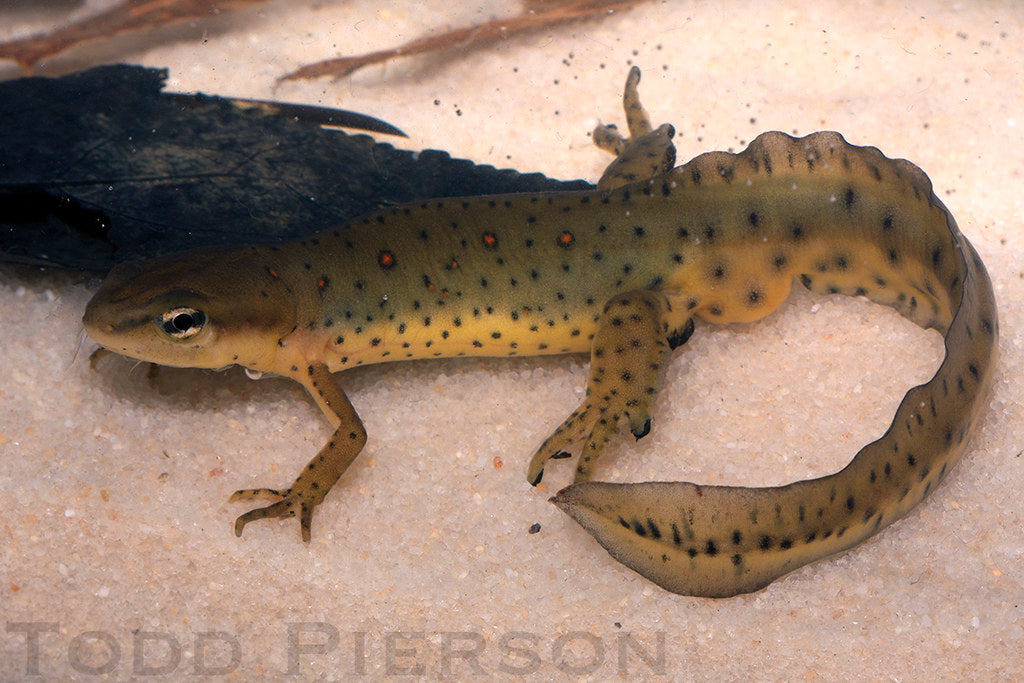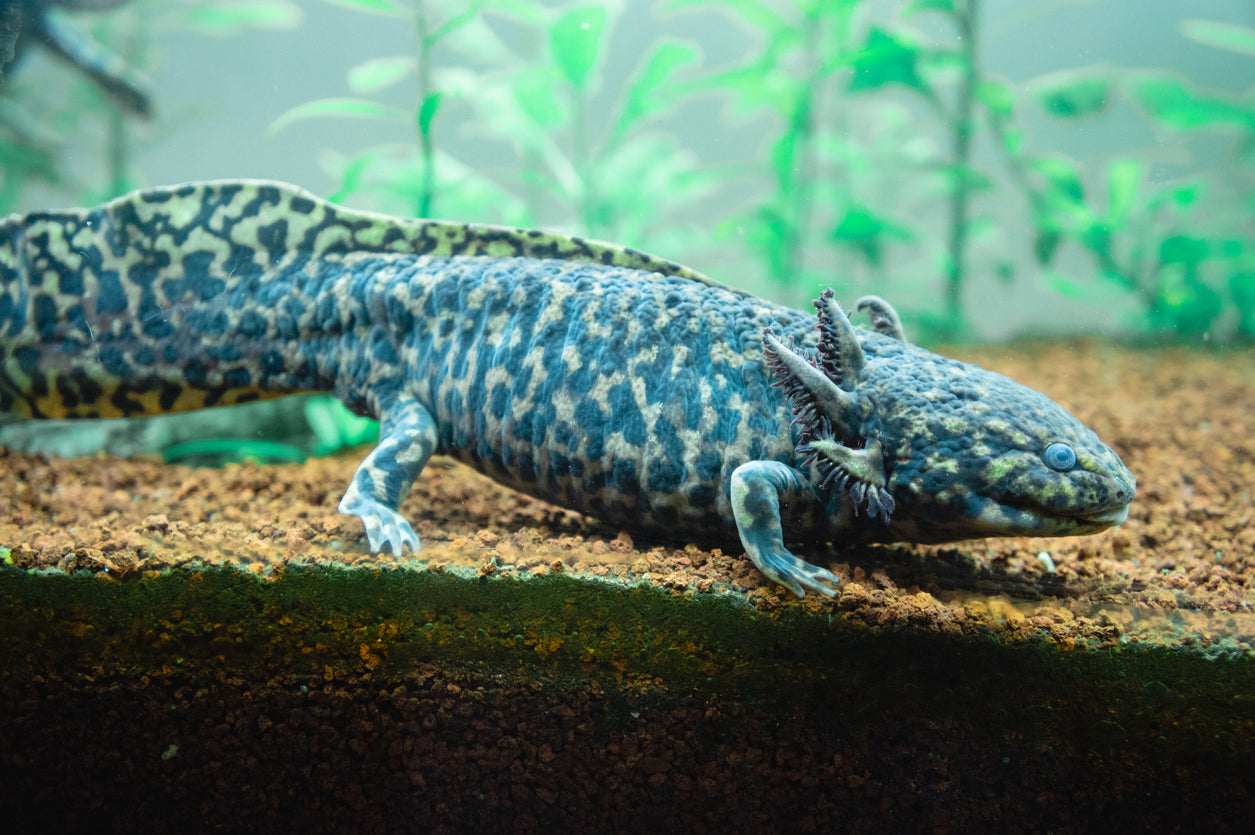Eastern newts (Notophthalamus viridescens) are small, semi-aquatic amphibians. They are native to eastern North America, primarily southern Canada and the United States, excluding Mexico. They are entirely aquatic as larvae, terrestrial as red efts, and semiaquatic as adults. They prefer muddy, forested environments with access to a body of water.
Eastern newts are generally 2.5-5” long as adults. In their intermediate “red eft” stage, they are bright orange with dark ring markings on their back and no fins. As adults, their tail flattens into a paddle-like shape and their color shifts to tan or olive-brown with brown/black and orange spots. Both stages have horizontal pupils.
Due to their semiaquatic nature and mild toxin, Eastern newts are intermediate-level pet amphibians. With good care, they can live up to 15+ years!
Note: Eastern newts may be very common in the US, but you should never take them from the wild to keep as pets! If you want a pet Eastern newt, please purchase one from a breeder.
How much space do Eastern newts need?
Eastern newts need roughly the same amount of space as both juveniles and adults, although the enclosure needs to be laid out differently for each stage (this will be discussed later). The minimum size for housing up to three Eastern newts is 20”L x 10”W x 10”H, or a standard 10 gallon tank. However, larger is preferred. There should be a tightly-fitting lid on top to prevent potential escape.
Do Eastern newts need UVB?
It’s best practice to provide UVB lighting for your newt’s optimal health and wellbeing. Adults are active during the day and night, which means that it’s very likely they’re naturally exposed to sunlight on a regular basis. Providing UVB lighting to your newt gives them all of the vitamin D that their body needs, stimulates better appetite and activity, and generally allows them to be healthier than they would be without.
The best UVB bulbs for Eastern newts housed in a 10 gallon enclosure is the Zoo Med Compact Fluorescent Reptisun 5.0, 26w. This bulb should be housed in a reflective fixture like the 12” Zoo Med Naturalistic Terrarium Hood, and placed on top of the mesh lid. UVB is blocked by glass and plastic, so you can’t give your newt UVB by placing the enclosure in front of an open window. UVB bulbs decay over time, so don’t forget to replace your bulb every 6 months to maintain good performance.
Lights should be on for 14.5 hours/day during summer and 9.5 hours/day during winter to simulate natural seasonal cycles.
What basking temperatures do Eastern newts need?
Eastern newts are ectotherms, which means that they rely on the temperature of their environment to help regulate their metabolism and stay healthy.
This species likes cool temps, so the water temperature should stay between 60-70°F, and the air temperature should stay between 65-70°F. Measure the temperatures in both of these areas with digital thermometers for best accuracy.
Eastern newts heat stress easily. So if you are unable to maintain appropriately low temperatures for them, then this is not the pet for you.
What humidity levels do Eastern newts need?
If you are caring for a red eft, then you will need to provide a humid terrestrial environment for them during this phase. It will take up to 2-3 years for them to grow into their adult appearance. During this time, make sure the enclosure offers high humidity levels of around 80%, measured via digital probe hygrometer. Mist the enclosure 1-2x/day with a spray bottle, and provide a humid retreat like a resin hide or small cork flat for the eft to use.
What kind of water maintenance do Eastern newts need?
Adult Eastern newts spend most of their time in the water, so it’s important to keep the water in the aquarium clean in order to keep your pet healthy. One of the best things you can do to accomplish this is to install a good aquarium filter, rated for the amount of the water in the tank.
However, you will also need to perform partial water changes (20-30%) once per week. Any water added to the aquarium should be treated with dechlorinator like Zoo Med Reptisafe to prevent harmful chemicals from being introduced to your pet’s habitat, as amphibians are very sensitive to the chemicals in their environment.
Algae buildup should be manually scrubbed off with a brush or magnetic glass scrubber.
What substrate is good for Eastern newts?
During the terrestrial eft stage, use a moisture-friendly substrate like Zoo Med ReptiSoil, Zoo Med Eco Earth, Exo Terra Plantation Soil, or sphagnum moss. If you plan to use live plants in the terrarium, make sure to choose a substrate that will support plant growth. This substrate should be replaced once per month.
For semiaquatic adults, substrate is optional, but it does make the aquarium more attractive, and it supports plant growth if you want a planted aquarium. Fluorite, aquarium gravel, and Exo Terra Riverbed Sand can be good choices. This substrate should be cleaned via siphon with every water change.
What décor can you use in an Eastern newt enclosure?
It’s terribly boring for a newt to be stuck in an enclosure with nothing in it. It doesn’t matter how big the enclosure is if you don’t put things in it for your pet to use and interact with.
At minimum, efts need places to hide and adults require at least one haul-out area to leave the water as needed. Other decor options for Eastern newts include:
- mopani wood
- cork bark
- rocks
- live or artificial plants
- pre-made hides/caves
- artificial ornaments
Whatever you choose to use, make sure that the newt has cover to hide in so it can feel secure in its environment.
What do Eastern newts eat?
Eastern newts are primarily carnivores, which means that they need to eat whole animal prey in order to get the nutrition that they need. In the wild, they aren’t picky, eating just about anything that they find, from mosquito larvae to frog spawn. Over food every other day, as much food as they will eat within ~10 minutes. Clean up any excess at the end to help maintain good water quality.
Food options for Eastern newts:
- Blackworms
- Bloodworms
- Brine shrimp
- Crickets
- Earthworms (chopped)
- Fish
- Tubifex worms
- Salamander pellets
Certain commercial diets such as Omega One Newt & Salamander Pellets and Hikari Sinking Carnivore Pellets are a good idea to include in your newt’s diet because they will help ensure that your pet is getting enough vitamins and minerals.
Drinking water
Red efts need access to a shallow water dish in their terrarium for drinking and soaking. Change the water daily and scrub the bowl with a reptile-safe disinfectant weekly.
Do Eastern newts like to be handled?
Very few amphibians actually “like” to be held, and given that Eastern newts are slightly toxic and semiaquatic, it’s best to treat them like fish and keep your hands off this pet.
*This care sheet contains only very basic information. Although it’s a good introduction, please do further research with high-quality sources to obtain additional information on caring for this species.
"Notophthalmus viridescens: Eastern Newt" by Todd W Pierson is licensed under CC BY-NC-SA 2.0




Leave a comment
This site is protected by hCaptcha and the hCaptcha Privacy Policy and Terms of Service apply.